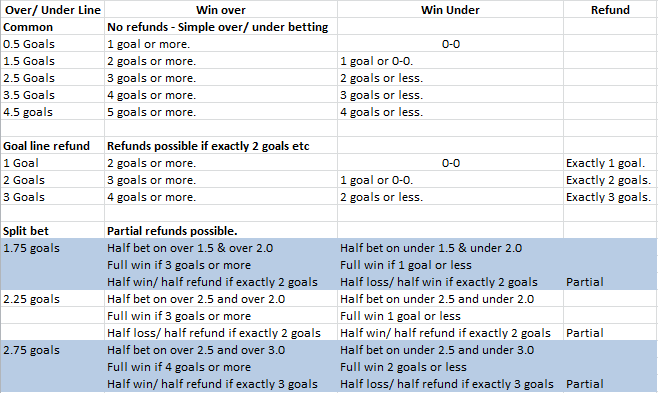What does -3 and +3 mean in NFL betting? A -3 spread means that the favorite must win by more than a field goal to win the wager. A three-point win would result in a push and the sportsbook would refund the wager. A spread of +3 means the team listed as the underdog must win the game or lose by fewer than three points to cash the bet. See full list on wikihow.com.
Point spread betting is the most popular form of sports betting. The vast majority of sports wagers use a point spread thanks to the popularity of football and basketball. Even though this type of betting is so popular, it may take awhile to understand.
1/2: For every 2 units you stake, you will receive 1 unit if you win (plus your stake). Sometimes you will see Evens or EVS displayed. This is the equivalent of a 1/1 fraction. Again it means the horse in question is expected to win the race. EVS: For every 1 unit you stake, you will receive 1 unit if you win (plus your stake).
The point spread is sometimes known as an equalizer for sportsbook operators. All teams aren’t created equally, so sportsbooks can create a point spread for a game so that each team playing has an almost even chance of winning the game. In a way, the point spread will even the field for both teams.
The point spread gives a reason for bettors to risk money on both teams. The better team playing in the game is considered favorite. They have to win by the point spread offered by the sportsbook. The favorite in a game is listed as being minus (-) the point spread.
What Do 3 To 1 Odds Mean
The worse of the teams playing in the game is called the underdog. The bettor wins if this team wins the game outright or loses by an amount smaller than the point spread. The underdog in a game is listed as being plus (+) the point spread.
Let’s use this past Super Bowl between the Tampa Bay Buccaneers and Kansas City Chiefs as an example.
Using this example, the Chiefs were 3-point favorites over the Buccaneers. The Chiefs needed to win by 4 or more points to cover the spread.
Likewise, the Buccaneers were 3-point underdogs. That means the Buccaneers needed to win the game outright or not lose the contest by 4 points or more. At Chiefs -3, if they won by exactly 3 points, the betting result would have been a “push” and bettors for both sides would have gotten their wagers refunded.
The Buccaneers pulled off the upset, winning by a score of 31-9, and rewarded bettors who backed them at +3.
Point spread betting odds
Point spreads are usually set with -110 odds, but pricing often fluctuates at online sportsbooks. This is the sportsbook operators’ house edge. The odds guarantee the sportsbook operator will see a little money over time. When the odds are set at -110, the bettor must wager $110 to win $100 (or $11 to win $10).
The odds on a point spread are most commonly known as the vigorish or “vig” for the sportsbook. You might hear this small profit margin for the sportsbook called the “juice” by some sports bettors.
Point spread FAQs

What does ‘pick em’ or ‘pick’ mean in NFL betting?
Idiot's Guide To Odds Ratios — JournalFeed
A “pick em” (sometimes seen as “pick”) is when the teams have a point spread of zero, meaning neither team is favored. In this instance, you’re essentially picking moneyline and your bet will be determined on the winner alone.
What does -7 and +7 mean in NFL betting?
A spread of minus-seven (-7) means that a is favored to win the game by a touchdown (technically, a touchdown and the extra point). A team favored by -7 must win the game by eight or more points to win the bet. If the team wins by seven, the result is a “push” and the bet is refunded.
A spread of +7 means the team must win the game or lose by fewer than seven points to win the bet. A loss by seven would result in a push.
What does -3 and +3 mean in NFL betting?
A -3 spread means that the favorite must win by more than a field goal to win the wager. A three-point win would result in a push and the sportsbook would refund the wager.
A spread of +3 means the team listed as the underdog must win the game or lose by fewer than three points to cash the bet. A three-point loss would be graded as a push by the sportsbook and the bet would be refunded.
Why are point spreads in the NFL so much lower than in college?
In 2019, the Baltimore Ravens led the NFL in point differential per game at +13.7 points; the Miami Dolphins ranked last in the NFL in point differential per game at -11.7. Even Kansas City– known for their explosive offense– had an average point differential in 2019 of just 9.7 points. The net point differential in the NFL is -14.1, or -0.9 points per game. Basically, the talent differential in the NFL is so minute that even mismatched teams often draw games within a score of each other.
NFL spreads are most commonly between one point and four, with six being a heavy favorite and extremes coming out around 15-20 point favors. (For those wondering, the 1941 Chicago Bears hold the NFL record of point differential at +15.7 points per game. Conversely, Ohio State had a +33.1 average point differential in 2019.)
Point spread and odds movement
Sportsbook operators often aim to have equal money on both sides of a point spread. When the money is exactly split the sportsbook operator will see the exact vigorish as their profit margin. If all things are equal over time this will maximize how much money the sportsbook operator can make.
In an effort to have equal money on both sides of a wager, the sportsbook operator will move the point spread to attract money on the side that customers aren’t betting on. The odds for a point spread might change before the actual point spread. There are certain point spread numbers, like 3 and 7 in football, the sportsbook operators would like to avoid moving away from since the final score margin falls on these two numbers most often.
For example, if a lot more money is wagered on the New England Patriots -3, the vig may shift from -112 to -115 and -120 before the line moves to -3.5.
Run and puck lines
Football and basketball games are mostly bet using a point spread. The less popular major sports, baseball and hockey, are mostly bet using a moneyline. In an effort to make baseball and hockey more appealing to point spread bettors, the sportsbook operators offer run and puck lines, respectively.
These alternative lines give point spread bettors a chance to wager on other sports using a more familiar method of betting. Since points (runs and goals) aren’t as easy to come by in baseball and hockey, the odds with the lines may have a wider spread than a football or basketball game.
There are two ways odds – or prices – are displayed at racecourses in Britain: the traditional fractional system or the more recently introduced decimal system.
Fractional odds:

These are usually displayed in this format: 4/1.
In spoken form this is “Four-to-one” and sometimes this can be written as: 4-1.
Odds are just maths. To illustrate some examples, let’s call each number a unit. So:
4/1: For every 1 unit you stake, you will receive 4 units if you win (plus your stake).
7/2: For every 2 units you stake, you will receive 7 units if you win (plus your stake).
9/4: For every 4 units you stake, you will receive 9 units if you win (plus your stake).
If you see fractional odds the other way round – such as 1/4 – this is called odds-on and means the horse in question is a hot favourite to win the race.
In spoken form this is “Four-to-one on”.

What Does 3 To 1 Odds Mean In Horse Racing
1/4: For every 4 units you stake, you will receive 1 unit if you win (plus your stake).
1/2: For every 2 units you stake, you will receive 1 unit if you win (plus your stake).
Sometimes you will see Evens or EVS displayed. This is the equivalent of a 1/1 fraction. Again it means the horse in question is expected to win the race.
EVS: For every 1 unit you stake, you will receive 1 unit if you win (plus your stake).
Decimal odds:
These are usually displayed in this format: 5.00.
5.00: Simply multiply this number by your stake to calculate your total potential returns if you are placing a win bet. Unlike fractional odds, your stake is already factored into this price i.e. this is the equivalent of 4/1 plus the 1 unit you stake.
Favourites:
Each race has a favourite. This is the horse most likely to win, which is reflected in having the shortest price displayed with betting operators.
You will see an F alongside the horse’s odds when they are the favourite. If more than one horse has the same odds of winning according to the betting market, this will be displayed as JF, meaning joint-favourite.
What about odds when betting each-way?
Racecourse bookmakers operating at Jockey Club Racecourses must meet (or exceed in the customer’s favour) a standard set of terms if you decide to place an each-way bet.
You will appreciate it is not affordable for bookmakers to pay out on all four places in a four runner race (!) so these agreed terms concerning place part of your each-way bet have to vary dependent on the number of runners and type of race. These are:
• Races with 3 or runners: win bets only, unless the bookmaker chooses to offer 1/5 (one fifth) of the stated odds for finishing 1st or 2nd
• Races with 3 or 4 runners: 1/5 (one fifth) of the stated odds for finishing 1st or 2nd
• Races with 5 to 7 runners (inclusive): 1/4 (one quarter) odds for finishing 1st or 2nd
• Races with 8 or more runners: 1/5 odds for finishing 1st, 2nd or 3rd
• Handicap races with 12 to 15 runners (inclusive): 1/4 odds for finishing 1st, 2nd or 3rd
• Handicap races with 16 to 21 runners (inclusive): 1/5 odds for finishing 1st, 2nd, 3rd or 4th
• Handicap races with 22 or more runners: 1/4 odds for finishing 1st, 2nd, 3rd and 4th